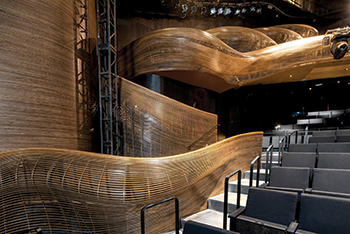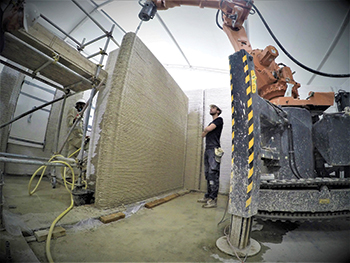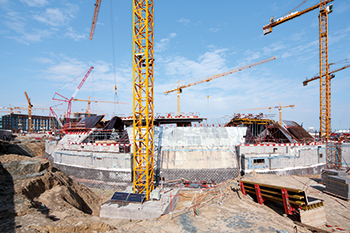
 Peri formwork ... helping shape the indoor tennis centre at the university’s Al Shadadiya campus.
Peri formwork ... helping shape the indoor tennis centre at the university’s Al Shadadiya campus.
An architecturally sophisticated dome-shaped building that will house an indoor tennis centre is currently taking shape at Kuwait University’s Al Shadadiya campus thanks to German firm Peri’s expertise in the area of freeform formwork.
The centre, part of the university’s Student Activities and Athletic Facilities Project (SAAF), will provide athletes and students with 7,100 sq m of space for their daily training activities. The building also has three floors and space for around 2,000 spectators. Externally, the sports venue impresses with its dome-shaped roof that has been designed in the traditional Islamic architectural style.
Trusting the experience of Peri in the area of freeform formwork, key players in the project – namely Gulf Consultants, Kuwait University and construction company Societe d’Enterprise & de Gestion (SEG Qatar) – tasked the formwork specialist to come up with a customised solution for the dome-shaped building designed by the US’ Skidmore, Owings and Merrill (SOM).
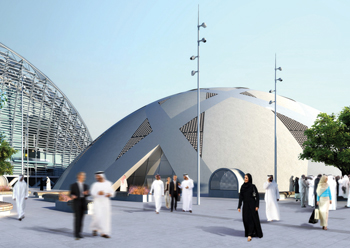 |
|
An artist’s impression of the indoor tennis centre designed by SOM. |
According to a Peri spokesman, the company planned and delivered a project-specific solution for the building to realise the vision of the firm of architects.
The facade of the 25-m-high tennis centre was constructed using eight concreting heights. Triangular recesses were taken into consideration in the construction of the thin reinforced concrete slab, which would be later enhanced with Trencadis mosaics made of limestone.
The recesses were positioned at different heights of up to 11 m and have up to 120 circular openings with diameters of 20 cm. These form a fine net that allows the natural sunlight to filter through the subsequently integrated glass blocks into the interior of the tennis centre. As a result, the sports venue measuring more than 80 m in diameter will be illuminated in a unique way.
Engineers from Peri’s technical office in Germany produced 3D building models as well as 3D plans on the basis of the building plans.
Customised 3D special formwork elements were used to construct the curved reinforced concrete walls of the complex, featuring differently-sized box-outs along with wall thicknesses varying between 20 and 30 cm. In the process, the statically load-bearing elements were based on the Vario GT 24 girder wall formwork.
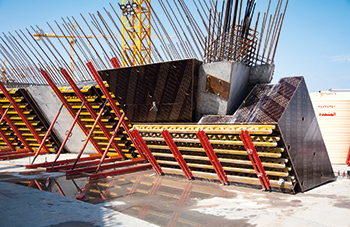 |
|
Customised 3D formwork elements were used for constructing the curved reinforced concrete walls with differently sized box-outs. |
The 3D formwork units and individual elements were assembled in accordance with Peri’s plans directly on site by the site personnel after they had received comprehensive training by a Peri supervisor.
To efficiently and accurately achieve the building’s shape with its demanding architectural requirements, Peri formwork and shoring solutions were perfectly matched to each other. Through the continuous system grid of 25 cm or 50 cm as well as the possibility of combining with SRU steel walers taken from the Variokit Engineering Construction Kit, the Peri Up Flex Modular Scaffolding System in the form of a load-bearing structure could be optimally adapted to accommodate the different geometries and loads of the free-form formwork. The shoring system was also used as a safe and stable working platform for the construction team.
The spokesman says that some of the challenges faced by the contractor included the space constraints of the site, limited availability of crane times as well as scheduling difficulties to manage other work on site such as the installation of the spectator precast seating.
As the shape of the curved walls repeated itself horizontally within a concreting height, it was possible to utilise the special formwork elements multiple times, he says.
“This meant it was possible to use the same formwork elements up to four times with each concreting operation. This reduced the construction costs and also saved valuable assembly time on the construction site,” says the spokesman.
He says Peri supervisors supported the construction team in ensuring efficient and safe handling of the Peri systems.
“A Peri project manager assisted the site management in facilitating strict adherence to the construction schedule and cost plan. He ensured the smooth flow of all processes and work activities in the area of formwork and scaffolding technology – especially regarding the delivery logistics.
“As a result, the profitability of the project was not only ensured by the project-specific optimised use of the equipment but, in particular, by the constant supervision and adaptation of the material quantities on the jobsite,” the spokesman points out.
Importantly, all processes involved in the planning and logistics along with the formwork assembly were precisely tracked and timed by the Peri project manager, and matched to the actual construction process down to the last detail, he concludes.
Currently under construction, SAAF includes a number of components which apart from the indoor tennis centre, comprise two athletic, recreational and aquatic centres – one for men and the other for women; two athletic and recreational facility – one each for men and for women; grand stadium and outdoor athletic facilities; information booths; student union centre; and public transportation station. The Kuwait University’s Al Shadadiya campus was planned in 2004.
Upon completion, the new campus will bring together all 16 faculties of the university and its 40,000 students at one central location over an area of 600 hectares. A total of seven different colleges – from the College of Art and College of Business through to the College of Architecture – will be accommodated on the area.





















_0001.jpg)


.jpg)
















.jpg)








.jpg)




